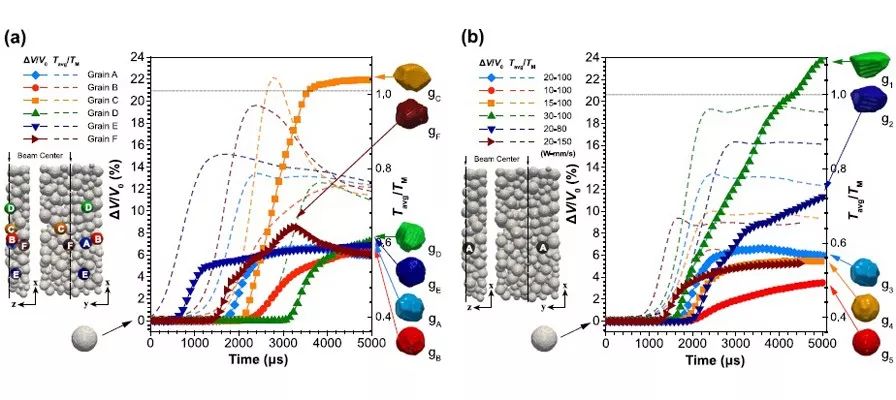

激光增材制造过程中微结构及其演化
电子说
描述
激光增材制造过程中微结构及其演化与制造参数之间关联的计算预测,已成为基于增材制造的材料/结构设计和开发过程的重要组成部分。选区激光烧结(SLS)增材制造过程中,微结构演化极度依赖于局部温度的急剧变化,故而常规的等温相场模型很难适用于SLS的模拟。
来自德国达姆施塔特工业大学的终身教授胥柏香领导的团队,与南京航空航天大学的青年千人易敏教授合作,建立了一种热力学自洽的非等温相场模型,用以研究SLS增材制造中微结构的演化。该模型考虑微结构与热传导的强耦合,SLS局部极高温导致的局部熔化,以及激光-粉末相互作用。并提出了一种类似于求解最小着色数问题的新解决方案,结合晶粒追踪方法,该方案可仅用8个序参量来模拟具有多达200个晶粒的系统。本研究还使用了基于LM算法的非线性优化方法,同时拟合模型与实验中表面能,晶界能随温度变化的趋势,以获取用于非恒温相场的模型参数。特别地,将该非等温相场模型用于SLS处理316L不锈钢粉末的研究,揭示了激光功率和扫描速度对孔隙率、表面形貌、温度分布、晶粒几何形状以及致密度等微观结构特征的影响规律,并证实了该模型可用于预测SLS过程中致密化因子与激光比能量之间的关联。该工作提出的非等温相场模型及其相关高效数值方法,有望用于SLS增材制造的大规模计算模拟。
该文发表于npj Computational Materials 5: 81 (2019)。

3D non-isothermal phase-field simulation of microstructure evolution during selective laser sintering
Yangyiwei Yang, Olav Ragnvaldsen, Yang Bai, Min Yi & Bai-Xiang Xu
During selective laser sintering (SLS), the microstructure evolution and local temperature variation interact mutually. Application of conventional isothermal sintering model is thereby insufficient to describe SLS. In this work, we construct our model from entropy level, and derive the non-isothermal kinetics for order parameters along with the heat transfer equation coupled with microstructure evolution. Influences from partial melting and laser-powder interaction are also addressed. We then perform 3D finite element non-isothermal phase-field simulations of the SLS single scan. To confront the high computation cost, we propose a novel algorithm analogy to minimum coloring problem and manage to simulate a system of 200 grains with grain tracking algorithm using as low as 8 non-conserved order parameters. Specifically, applying the model to SLS of the stainless steel 316L powder, we identify the influences of laser power and scan speed on microstructural features, including the porosity, surface morphology, temperature profile, grain geometry, and densification. We further validate the first-order kinetics of the transient porosity during densification, and demonstrate the applicability of the developed model in predicting the linkage of densification factor to the specific energy input during SLS.

- 相关推荐
- 热点推荐
- 增材制造
-
增材制造技术是干什么的 增材制造技术有哪些类型2024-06-07 11378
-
增材制造技术发展趋势有哪些2023-04-26 2066
-
Ntron氧气分析仪在金属增材制造过程中的应用2021-09-02 1874
-
相场模拟—尽“显”增材制造过程中的晶粒演化2021-06-15 2689
-
增材制造的优势_增材制造的应用2021-05-26 11194
-
激光增材再制造技术及其应用2020-12-25 1721
-
恩耐推出用于增材制造市场的AFX-1000光纤激光器2020-11-06 3273
-
电子束增材制造技术用于金属材料的多材料增材制造2020-04-16 5962
-
激光增材制造中的过程监控的设备及如何保证质量2018-09-20 4921
-
纳米增材制造2018-02-11 1340
-
纳秒激光脉冲诱导硅表面微结构2010-04-22 2419
全部0条评论

快来发表一下你的评论吧 !

